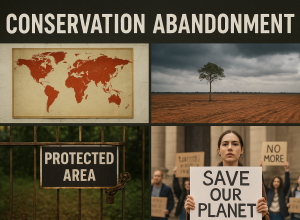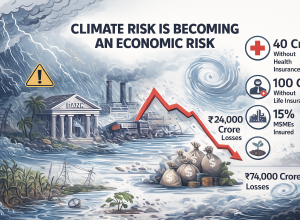Walking outside huge fashion streets and stores in the country and worldwide, it is interesting to see brands that are so intensely associated with overconsumption, starting to introduce sustainability initiatives. Many of them even explicitly ask you to not buy clothes unnecessarily. Millions of discarded clothes end up as waste, piling up in landfills and creating mountains of textile cast-offs. The majority of these items could have been re-worn, reused, or recycled, yet they continue to end up as waste.
This growing issue is putting major retailers under increasing pressure to take meaningful action and implement more responsible waste management practices.
While companies like Adidas and luxury giant Kering — the parent company of brands such as Alexander McQueen and Gucci — have set ambitious targets for collecting used garments, the broader goal is clear: to ramp up textile recycling, keep clothes out of landfills, and give fashion waste a second life.
H&M’s Conscious Collection and Zara’s Join Life line exemplify efforts to incorporate recycled materials and promote circular fashion. Yet, industry observers have made claims that despite these initiatives, both brands continue to face scrutiny over their broader environmental impact and accusations of ‘greenwashing’, raising questions about the authenticity and depth of their sustainability claims.
With glossy catwalks, glitzy trends, and overnight sensations, it’s true that fashion is a world built on constant reinvention. Yet behind the allure of the latest drop lies a deeply frayed system. The global fashion industry, worth a staggering $1.84 trillion and contributing 1.63% to the world’s GDP, is confronting a long-overdue reckoning. As the climate crisis intensifies and consumers demand accountability, fashion must grapple with an uncomfortable truth: its allure comes at an immense environmental and human cost.
The industry alone contributes 8–10% of global carbon emissions—more than all international flights and maritime shipping combined. Each year, it generates 92 million tons of textile waste, with much of it either incinerated or dumped in landfills. A single cotton shirt guzzles over 2,700 litres of water during its production, while the industry as a whole consumes a jaw-dropping 79 trillion litres annually. Then there’s the plastic: synthetic fabrics release over 500,000 tons of microplastics into waterways each year. Compounding this crisis is the grim social reality—an estimated 50 million people are trapped in modern slavery, many within the opaque corners of the fashion supply chain.
But fashion’s unravelling isn’t just a crisis. It is an opportunity. Driven by regulation, consumer demand, and innovation, a systemic transformation is taking root—one that promises to redefine fashion from fibre to finish.
Spotlight on India’s Fashion Industry
In India, one of the world’s largest garment producers and exporters, the fashion supply chain is marked by both promise and peril. The 2024 Fashion Transparency Index flagged major transparency gaps globally—but Indian brands were especially concerning. According to the Advertising Standards Council of India (ASCI), nearly 79% of environmental claims made by Indian brands were either misleading or completely unsubstantiated.
This trust gap is wide: only 29% of Indian consumers say they trust sustainability claims made by fashion brands. That skepticism is well-founded. Investigations by non-profit Transparentem in Madhya Pradesh revealed forced and child labour across 90 cotton farms, with workers exposed to toxic chemicals and bound by exploitative contracts. Despite these abuses, raw material suppliers—especially those in Tier 2 and Tier 3 cities—are rarely disclosed in brand reports, keeping violations hidden from public scrutiny.
This opacity also fuels greenwashing. Just as European regulators struggle to verify the authenticity of “recycled yarns” or eco-labels, India’s regulatory frameworks remain nascent. Brands can still advertise sustainability while dodging genuine accountability.
The World Watches
Globally, governments are raising the bar. The EU is at the forefront, rolling out sweeping reforms like the Ecodesign for Sustainable Products Regulation (ESPR) and the Corporate Sustainability Due Diligence Directive (CSDDD). These policies enforce strict standards on durability, recyclability, and human rights due diligence. Meanwhile, the Digital Product Passport (DPP) will soon require every product to come with a scannable QR code that reveals its environmental impact and supply chain footprint.
The U.S. is not far behind. New York and California have banned PFAS “forever chemicals” in clothing starting 2025, while Extended Producer Responsibility (EPR) laws in states like Oregon and California are shifting waste disposal costs back to the brands. The Uyghur Forced Labor Prevention Act (UFLPA) is also being enforced with greater rigor, underscoring the rising scrutiny on unethical labour practices.
Fashion’s Digital Thread
As policy tightens, technology is stepping in to bridge the compliance gap. Blockchain is revolutionizing traceability by creating tamper-proof records of a product’s journey. Brands like Givenchy and Breitling are already using it to authenticate products and verify ethical sourcing. Artificial Intelligence is being deployed to refine demand forecasting, helping brands slash the overproduction that fuels fashion waste. Over 70% of mass-market design now uses 3D sampling—reducing the need for physical prototypes and cutting time-to-market drastically.
On the recycling front, companies like Circ and Syre (partnering with H&M in a $100 million initiative) are pioneering closed-loop systems to recover and reuse cotton and polyester from discarded clothes. Yet the biggest challenge remains scale. While these breakthroughs are promising, they’re still far from replacing the global supply chain’s vast output.
The Conscious Consumer Is Here to Stay
Fashion’s new power players aren’t designers or CEOs—they’re conscious consumers, especially Gen Z. A remarkable 73% of Gen Z buyers say they’re willing to pay more for sustainable products. Globally, three out of five shoppers now consider sustainability when making purchasing decisions.
This shift is transforming fashion’s economics. The resale market is booming, growing at 12% annually and poised to represent 10% of global apparel sales by end-2025. Even the popularity of ‘dupes’, the affordable alternatives to luxury products, reflects a rising awareness that value isn’t just about price tags, but also about ethics, craftsmanship, and longevity.
Indian consumers are also leaning into this shift. There’s growing support for small, artisan-driven labels that emphasize fair wages, traditional techniques, and lower environmental footprints. The demand for transparency is turning the spotlight on brands that embrace purpose over profit.
Strategies for a Sustainable Tomorrow
Rebuilding the fashion industry from the ground up demands sweeping reforms. At the heart of this lies radical transparency. Disclosing only Tier 1 suppliers is no longer enough; brands must trace their materials to the farm or mine. Technologies like blockchain and initiatives like the Higg Facility Environmental Module (FEM) are helping brands gather real-time environmental and social data. Movements like Fashion Revolution are amplifying the push for visibility, calling for a new era of open accountability.
Decarbonisation is another key pillar. Since 70% of emissions occur in the early supply chain, investments in renewable energy, regenerative agriculture, and innovations like waterless dyeing are crucial. Brands such as Primark are taking first steps by designing garments to withstand 45+ washes—reducing their water, carbon, and waste footprints by nearly 30%.
A material revolution is also underway. With over 70% of textiles still made from fossil-fuel-derived synthetics, shifting to organic cotton, recycled fibres, and bio-based materials is imperative. Innovations like Mirum (plant-based leather) and Biosteel (biodegradable fibre used by Adidas) hint at a plastic-free future—but scaling them will require major R&D investments.
Circularity, once a buzzword, is fast becoming a business imperative. From design-for-disassembly to large-scale recycling infrastructure and take-back programs, the industry is learning to close the loop. France and Belgium’s EPR laws already compel brands to take responsibility for a garment’s entire lifecycle. Meanwhile, fast fashion giant Inditex is working with Ambercycle to scale up recycled polyester production.
None of this will work without ethical labour practices. Ensuring safe conditions and living wages—especially among invisible Tier 2 and Tier 3 suppliers—is not optional. Brands must go beyond audits, setting wage benchmarks and forging binding agreements. While “nearshoring” and “friendshoring” (producing closer to home or in politically friendly regions) are gaining ground, they introduce new challenges in capacity and cost.
🌏 Fashion Sustainability & Greenwashing: India vs Europe (2024 Snapshot)
| Category | India | Europe |
| Sustainability Claims Accuracy | 79% of green claims are exaggerated or misleading (ASCI) | 59% of claims found to be vague or unverifiable (EU Commission) |
| Consumer Trust | Only 29% of consumers trust sustainability claims (ASCI) | Around 44% consumer trust in major European countries (EU Survey 2023) |
| Raw Material Supplier Disclosure | Very limited, <5% brands disclose Tier 2/3 suppliers (Transparentem) | Only 5% disclose raw material suppliers (Fashion Transparency Index) |
| Labour & Environmental Violations | 90 cotton farms in Madhya Pradesh found using forced & child labor | Labour exploitation mostly in outsourced supply chains (e.g., Bangladesh) |
| Government Regulation | ASCI Guidelines against greenwashing launched mid-2023 | EU Green Claims Directive introduced to standardize & verify claims |
| Focus of Activism & Scrutiny | Waste management, labour rights, textile waste | Fast fashion emissions, synthetic fibers, microplastics |
The Road Ahead
The path to sustainability is expensive, complex, and slow. Experts estimate that the global industry needs more than $1 trillion in investment to hit its sustainability targets. Smaller brands, which make up over 90% of the sector, often lack access to capital, technology, or certified suppliers. Fragmented global supply chains and the lack of standardised data make it hard to benchmark progress.
Still, the pressure to change is mounting. Regulatory frameworks like the EU’s Digital Product Passport and India’s evolving EPR policy are setting new norms. The climate clock is ticking, and brands that delay may find themselves left behind—not just in compliance, but in relevance.
The fashion industry, long defined by speed and spectacle, is learning to slow down and stitch purpose into its seams. A new era is unfolding—one that redefines success not by runway applause, but by impact, responsibility, and resilience.





